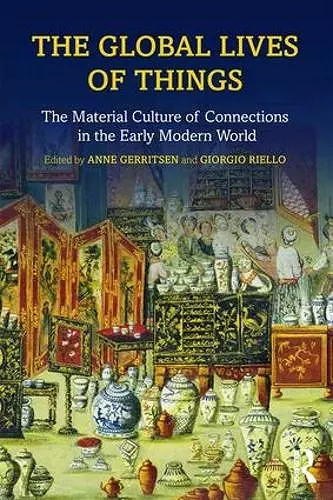The Global Lives of Things
The Material Culture of Connections in the Early Modern World
Anne Gerritsen author Giorgio Riello author
Format:Paperback
Publisher:Taylor & Francis Ltd
Published:1st Dec '15
Currently unavailable, and unfortunately no date known when it will be back
This paperback is available in another edition too:
- Hardback£155.00(9781138776661)

The Global Lives of Things considers the ways in which ‘things’, ranging from commodities to works of art and precious materials, participated in the shaping of global connections in the period 1400-1800. By focusing on the material exchange between Asia, Europe, the Americas and Australia, this volume traces the movements of objects through human networks of commerce, colonialism and consumption. It argues that material objects mediated between the forces of global economic exchange and the constantly changing identities of individuals, as they were drawn into global circuits. It proposes a reconceptualization of early modern global history in the light of its material culture by asking the question: what can we learn about the early modern world by studying its objects?
This exciting new collection draws together the latest scholarship in the study of material culture and offers students a critique and explanation of the notion of commodity and a reinterpretation of the meaning of exchange. It engages with the concepts of ‘proto-globalization’, ‘the first global age’ and ‘commodities/consumption’. Divided into three parts, the volume considers in Part One, Objects of Global Knowledge, in Part Two, Objects of Global Connections, and finally, in Part Three, Objects of Global Consumption. The collection concludes with afterwords from three of the leading historians in the field, Maxine Berg, Suraiya Faroqhi and Paula Findlen, who offer their critical view of the methodologies and themes considered in the book and place its arguments within the wider field of scholarship.
Extensively illustrated, and with chapters examining case studies from Northern Europe to China and Australia, this book will be essential reading for students of global history.
"Gerritsen and Riello's Global Lives of Things is a truly ground-breaking collections of essays. The volume bestrides the intersection of two of the most important recent developments in the study of history - the material turn and the global turn - and is the first to apply these in so concerted a way to the early modern period . The individual contributions, which range across Europe, China, India and Australia, and which consider commodities including sharkskin, coral and tobacco, are uniformly strong; together they highlight the connections between the local and the microcosmic and the international and the macrocosmic, to give a much better sense of the way early moderns lived their lives. This volume will be required reading not only for students of the early modern period, but also for those interested in the 'things' that have been used in the past, and the global connections which often lay behind them."
Kenneth Austin, University of Bristol, UK
"This pathbreaking volume explores how materials, artefacts and commodities traveled across the globe in the early modern period. Its object lessons shed light on how things in circulation could acquire new meanings and values, transform social relations, shape the environment, and set in motion novel constellations of knowledge. Combining approaches from material culture, economic history, consumption studies, and the history of science, The Global Lives of Things offers a perfect example of how global history needs to be studied in context."
Dániel Margócsy,, Hunter College, The City University of New York, USA
"Gerritsen and Riello's The Global Lives of Things is a truly ground-breaking collection of essays. The volume bestrides the intersection of two of the most important recent developments in the study of history - the material turn and the global turn - and is the first to apply these in so concerted a way to the early modern period . The individual contributions, which range across Europe, China, India and Australia, and which consider commodities including sharkskin, coral and tobacco, are uniformly strong; together they highlight the connections between the local and the microcosmic and the international and the macrocosmic, to give a much better sense of the way early moderns lived their lives. This volume will be required reading not only for students of the early modern period, but also for those interested in the 'things' that have been used in the past, and the global connections which often lay behind them."
- Kenneth Austin, University of Bristol, UK
"This pathbreaking volume explores how materials, artefacts and commodities traveled across the globe in the early modern period. Its object lessons shed light on how things in circulation could acquire new meanings and values, transform social relations, shape the environment, and set in motion novel constellations of knowledge. Combining approaches from material culture, economic history, consumption studies, and the history of science, The Global Lives of Things offers a perfect example of how global history needs to be studied in context."
- Dániel Margócsy, Hunter College, The City University of New York, USA
"Overall, this volume makes a valuable contribution to an emerging field (...) Summing Up: Recommended"
- J. Werner, Western Michigan University in CHOICE
"The editors and Routledge should be acknowledged for taking the various essays with their differing lengths and making them read smoothly as part of the same volume. (...) The chapters are well illustrated, and although there is not a map in every one, readers can locate the places mentioned in a particular text by looking at the maps contained in other chapters. Readers looking to deepen their knowledge of either the general trends or the particular details of the objects discussed, can avail themselves of the rich endnotes included with each chapter. As a result, both readers well-versed in the topics discussed, as well as those for whom they are completely new, will find, as Findlen notes in her afterword, that “small things can tell big stories” (page 244)."
- James G. Schryver, University of Minnesota
ISBN: 9781138776753
Dimensions: unknown
Weight: 520g
266 pages